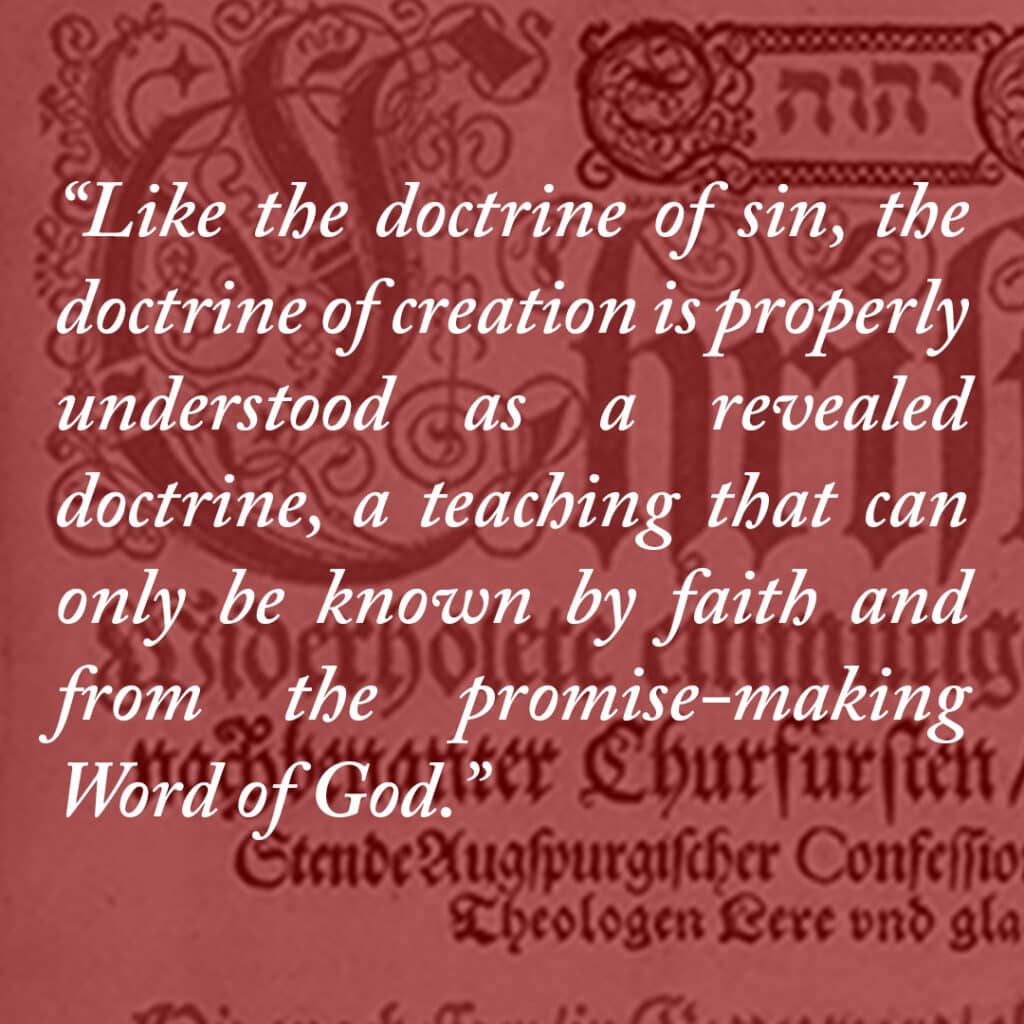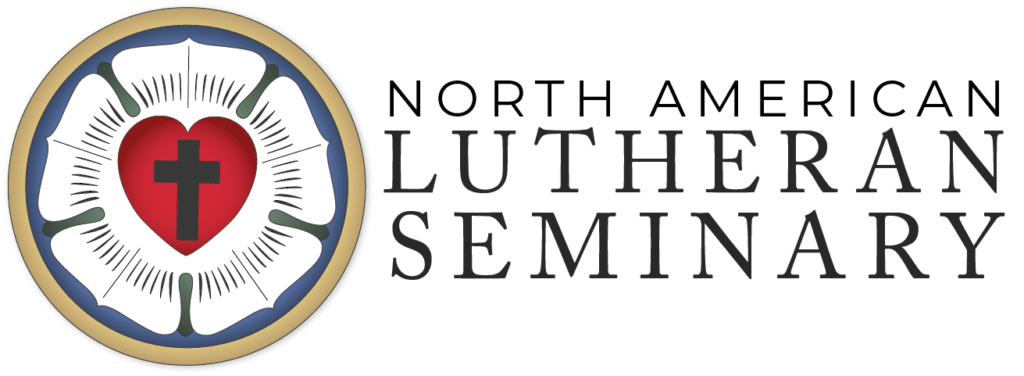On the Image of God
Dr. Alexander H. Pierce

The Lutheran Confessions paint a dire picture when it comes to the status of the divine image in human beings under the sway of sin. They state that we sinful humans have lost the “image of God” (imago Dei). In our sin, humankind has “a complete absence or ‘lack of the original righteousness acquired in paradise’ or of the image of God, according to which the human being was originally created in truth, holiness, and righteousness.”1 The authors of the Solid Declaration equate the image of God with humanity’s “original righteousness.” This loss amounts to “the absence of any ability or competence in anything that relates to God.”2 As sinful human persons, we are simply incapable of relating to God in a manner that is good and salutary.
This devastating state of affairs described in the Formula of Concord can be illumined by a brief look at the earlier work of Philip Melanchthon in the Apology. In the second article of the Augsburg Confession, the Wittenbergers had specified their understanding of the doctrine of original sin often associated with Augustine of Hippo. Upon receiving the accusatory Augsburg Confutation written by Catholics present at the 1530 Diet of Augsburg, Melanchthon pioneered the Evangelicals’ defense of the Augsburg Confession in the Apology of the Augsburg Confession. In further clarifying what the Wittenberg Reformers believed concerning original sin, the Apology explained that in addition to affirming concupiscence (i.e., disordered desire) as a consequence of original sin so also, on account of the biblical witness and the testimony of the tradition, they “denied to the natural powers of the human creature fear of and trust in God,” for they “wanted to show that original sin also included these maladies: ignorance of God, contempt for God, the absence of fear of and trust in God, and the inability to love God. These are the chief defects of human nature—in conflict especially with the first table of the Decalogue.”3
This twofold definition of original sin was summed up as follows in the Solid Declaration: “original sin deprives the unrenewed human nature of the gifts, powers, and all capacity to initiate and effect anything in spiritual matters” to such an extent that we not only have “a complete lack of all good in spiritual, divine matters,” but original sin also “replaces the lost image of God in the human being with a deep-seated, evil, horrible, bottomless, unfathomable, and indescribable corruption of the entire human nature and all of its powers, particularly of the highest, most important powers of the soul, in mind, heart, and will.”4 Our Lutheran Confessions, then, speak of concupiscence as replacing our image-bearing with a self-distorting form of existence.
The consequence of the fall of humanity, as Martin Chemnitz specifies it, is that, as Gen. 5 suggests, “‘Adam was created ‘in the image of God,’ but after the Fall, ‘he begot children in his own image.’”5 The image of God, or humankind’s original righteousness, was substituted for the image of sinful man, a subversion of our rightful subjection to God to an aberrant form of human life. The leaders and early heirs of the Wittenberg reform movement appreciated the unabated consequences and universal transmission of Adam’s sin to all humanity which Augustine had fought so hard to define centuries earlier. It shaped their theology of the image and of the state of sinful human persons. According to the hamartiology (i.e., the doctrine of sin) of the Book of Concord, “creatureliness and corruption mutually cover one another in the empirical observation of human reality… For every man is altogether both, creature and sinner, at the same time.”6 Although the Lutheran Confessions never grant to sinful humanity the possession of even an emaciated image, they do assert a “terrible dualism” of the human situation during this time of salvation history, a complete creatureliness amidst total corruption, a simul of life and death.7 In short, we are at once creatures whom God has given being and life and yet we are spiritually bankrupt, dead in our self-selected separation from God. The question you might be asking yourself at this point is, does all this mean that being confessionally Lutheran requires us to see humanity in general and ourselves in particular as downright evil? Yes and no.
The Lutheran Confessions—concrete and situational as they are—reveal how deeply Luther, Melanchthon, and their fellow reformers were concerned to reckon with the depth and reality of sin so that they might make space for a robust theology of grace by which to confront what had become a largely meritocratic Christendom.
For sinful humans in such a devastatingly desperate place, to recover true knowledge of God our Creator and humankind as created with the original righteous Adam lost requires us to be regenerated by the Holy Spirit who renews us in our new self in Christ “which is being renewed in knowledge according to the image of its Creator” (Col. 3:10) as we “are being transformed into the same image from one degree of glory to another, for this comes from the Lord, the Spirit” (2 Cor. 3:18). Like the doctrine of sin, the doctrine of creation is properly understood as a revealed doctrine, a teaching that can only be known by faith and from the promise-making Word of God.

In particular, we need what was lost, “a true knowledge, fear, [and] love of God, trust toward God, and the constant obedience of all his powers in keeping with the law of God.”8 The Apology itself defines the image as “a wisdom and righteousness that would grasp God and reflect God” which “was implanted in humankind, that is, humankind received gifts like the knowledge of God, fear of God, trust in God, and the like.”9 For those who have been regenerated through the waters of baptism, “they have been redeemed by the Son of God so that they may practice the law day and night (Ps. 119:1). For our first parents did not live without the law even before the fall. This law of God was written into the heart, for they were created in the image of God.”10 “All things came into being through him” (Jn. 1:3), “through him and for him” (Col. 1:16) who is “the image of the invisible God” (Col. 1:15), and “those whom [God] foreknew he also predestined to be conformed to the image of his Son” (Rom. 8:29). Christ is the image toward which we were created and in sin abandoned, but he is also the one who can renew us, and by His Spirit, make us to be bearers of God’s image and likeness. Creatures and the scoundrels all who must give thanks to God for the former and confess to God the latter, we can muse with Blaise Pascal, “What sort of freak then is man! How novel, how monstrous, how chaotic, how paradoxical, how prodigious! Judge of all things, feeble earthworm, repository of truth, sink of doubt and error, glory and refuse of the universe!”11
-
SD I.10 (Robert Kolb and Timothy J. Wengert [eds.], The Book of Concord: The Confessions of the Evangelical Lutheran Church [Minneapolis: Fortress Press, 2000], 533).
-
SD I.10 (K./W., 533).
-
Apol. II.14 (K./W., 114).
-
Solid Declaration I.10-11 (K./W., 533-534).
-
Martin Chemnitz, Loci Theologici, Part I, trans. Jacob O.C. Preus, Chemnitz’s Works 7, (St. Louis, MO: Concordia House Publishing, 2008), 510.
-
Edmund Schlink, Theology of the Lutheran Confessions, trans. Paul F. Koehneke and Herbert J. A. Bouman, Concordia Classics (St. Louis, MO: Concordia Publishing House), 47-48
-
Schlink, Theology of the Lutheran Confessions, 44
-
Chemnitz, Loci Theologici, Part I, 510.
-
Apol. II.18 (K./W., 115).
-
Ep. 6, Affirmative Thesis I (K./W., 502.2).
-
Blaise Pascal, Pensées (London: Penguin Books, 1995), 34.

